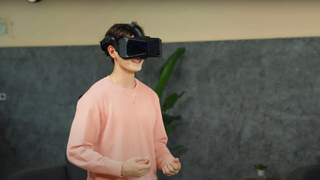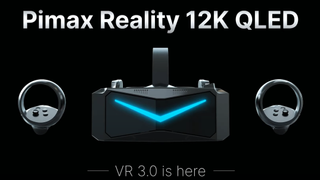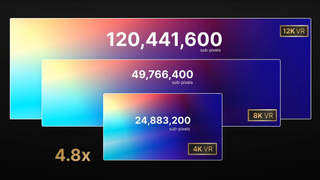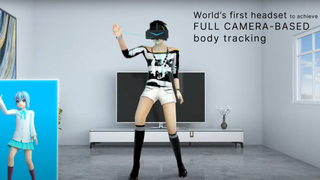Pimax's Next-Generation Reality 12K QLED VR Headset Defies Belief
Smaller, lighter and better in many ways, plus an internal processor for standalone use

Pimax today revealed a breathtaking new headset which it plans to release sometime in 2022. The Pimax Reality 12K QLED is probably the most advanced headset that we’ll hear about for a while, unless Oculus has something truly unexpected up its sleeve for later this week.
Pimax is constantly pushing the limits of what it can squeeze into a VR headset. Still, it’s hard to imagine what Pimax has planned is even possible with today’s tech. The Pimax Reality 12K QLED is smaller and lighter than previous models, and has a broader field of view and higher-resolution displays than even the company’s current flagship headset, the Vision 8K X. To top things off, it’s powered by an internal processor, giving it standalone capability.
A True Flagship Device
The Pimax Reality 12K QLED headset features dual 6K QLED, panels with mini-LED backlighting and 4400 elements for local dimming. Pimax said the headset features a wholly reimagined lens design, eliminating distortion and refractions and giving you edge-to-edge clarity. Pimax said the construction is a mix of Fresnel and aspheric lenses, and the company is calling them Bionic lenses.

Pimax increased the horizontal field of view (FOV) in the new headset by 30-degrees compared to the last generation, giving you a whole 210-degree viewing angle. The vertical FOV is also larger, now 135-degrees, which is more vertical vision than most human eyes can perceive.
To help improve performance on such high-resolution displays, Pimax has partnered with Tobii to integrate Tobii’s eye-tracking technology into all future Pimax headsets. The eye-tracking cameras can facilitate foveated rendering, which can dramatically improve VR rendering performance (Qualcomm says 2-3x) to allow for such high-resolution displays.

Along with the eye-tracking hardware, the Pimax Reality 12K QLED includes motorized IPD adjustment. Like with the Varjo Aero, when you put on the Reality 12K QLED, it will run an eye calibration process to ensure your eyes are lined up perfectly with the displays. Pimax said there would be a manual override button for calibration, but it’s unclear if it enables manual lens adjustment or manual triggering of the auto-calibration process.
PCVR Hybrid Headset
With specifications like those described above, you would likely think the Pimax Reality 12K OLED would be a tethered PC VR headset. But as noted up top, it's not. Incredibly, Pimax stuck a Qualcomm XR-2 chip inside the Reality 12K QLED headset, enabling you to use it as a standalone device without a computer.
Stay on the Cutting Edge
Join the experts who read Tom's Hardware for the inside track on enthusiast PC tech news — and have for over 25 years. We'll send breaking news and in-depth reviews of CPUs, GPUs, AI, maker hardware and more straight to your inbox.
The Reality 12K fits in a new category that Pimax calls a PCVR Hybrid. A PCVR Hybrid device gives you the best of both worlds, allowing for tethered PC use or standalone operation. When operating as a standalone device, the headset can run Android-based VR games, just like an Oculus Quest 2 or Vive Focus 3.

The headset can also accept a direct signal from your GPU via two Display Port 1.4 connections, or stream content from your PC through Wi-Fi 6 or WiGig.
Optical Tracking
With the change to a standalone configuration also comes a change to the way Pimax handles tracking. The current lineup of Pimax headsets pairs with Valve’s SteamVR tracking technology, and Pimax sells Valve’s Index controllers to complement its ultrawide headsets.

With the Reality 12K QLED, Pimax made the switch to optical SLAM-based tracking for headset positioning. The new headset will ship with a pair of optically tracked Pimax Sword controllers.
Pimax says it will also offer an accessory that would add SteamVR sensors to the headset for anyone who needs the extreme precision that Valve’s tracking solution provides.
Facial Expression and Body Tracking

The Pimax Reality 12K QLED headset comes equipped with several biometric tracking systems that allow you to bring your full expression into the game. In addition to the eye-tracking cameras, the 12K OLED includes face tracking cameras mounted on either side of the visor. It also supports mouth tracking, and even body tracking. A set of cameras on the bottom of the visor can detect your arm and leg movement, as well as your torso position.
Advanced Technology Doesn’t Come Cheap
The specs of the Reality 12K QLED are incredible, but you may want to be sitting for the next bit. Pimax says the price will be $2399 when the headset launches late next year. The company is at least planning to offer a discount to anyone who already owns a Pimax device. You can credit the full purchase price as a discount on a 12K QLED.

Pimax is planning to attend CES this year, and the company said that it would have more to announce about its future hardware in January at the event.
Kevin Henderson, COO of Pimax, told us that the current announcement is just the beginning. The 12K QLED model represents the pinnacle of Pimax’s next-generation hardware, and just like the Vision series, Pimax intends to have several products in its Reality line. We expect to see more-affordable Pimax Reality headsets in the future, but when that may be is anyone’s guess.
If you're concerned about the price of the new flagship headset, at least you have about a year to save up. Pimax says the Reality 12K QLED will be available in Q4 2022.
Kevin Carbotte is a contributing writer for Tom's Hardware who primarily covers VR and AR hardware. He has been writing for us for more than four years.
-
Phyzzi Well, if it lives up to the promises, it will absolutely be worth that price in a year. We'll see if it does, indeed, live up to the promises though, and what kind of horror show it ends up being if you try to do wireless connection. Also, was there a refresh rate? I hope they are doing at least 90 Hz.Reply
Anyway, from what I hear the current Pimax hardware (at the top) is pretty great, but the software isn't exactly plug and play. It seems like they have a bit of work to do software side if they want to make foviated rendering successful in a year (or maybe Steam VR has an upcoming announcement about that and everyone has just done a great job keeping the cat in the bag). Anyway, it could be a very exciting year in VR, if all the rumors and promises pan out. -
computerguy72 Reply
It's actually MUCH HIGHER than 6k. They also show at the end with the "one more thing" the headset includes a 6000PPI FRD display for the center region of the display. That area is extremely high resolution.peachpuff said:Two 6k screens does not equal 12k 🙄 -
TJ Hooker Reply
No, what they're calling 12K has only half the number of pixels of what would actually be 12K (although no 12K displays exist yet AFAIK). They're listing the number of sub-pixels (RGB, 3 sub pixels per pixel) rather than pixels for some reason though.computerguy72 said:It's actually MUCH HIGHER than 6k. They also show at the end with the "one more thing" the headset includes a 6000PPI FRD display for the center region of the display. That area is extremely high resolution.
Real 12K should have four times the pixels/sub pixels as 6K. Pixmax "12K" only has double the amount. -
computerguy72 Reply
No, at the end they have a section called "one more thing" where they show the center of the screen is close to 6000ppi and 70ppd using a high resolution projector for the center of the screen. So you are incorrect.TJ Hooker said:No, what they're calling 12K has only half the number of pixels of what would actually be 12K (although no 12K displays exist yet AFAIK). They're listing the number of sub-pixels (RGB, 3 sub pixels per pixel) rather than pixels for some reason though.
Real 12K should have four times the pixels/sub pixels as 6K. Pixmax "12K" only has double the amount. -
TJ Hooker Reply
I don't see any of that in this article, could you provide a link to what you're referring to? Either way, pixel density (PPI/PPD) and pixel count are two different things.computerguy72 said:No, at the end they have a section called "one more thing" where they show the center of the screen is close to 6000ppi and 70ppd using a high resolution projector for the center of the screen. So you are incorrect.
According to Pixmax's own slide (3rd image in this article), their "12K" headset has 120.4M sub pixels. A real 12K display would have 4x the sub pixels of a 6K display, so ~244M. -
spongiemaster Reply
Don't see what he's talking about either, but it sounds like something akin to Nvidia multi-res shading where items not in your direct line of site are rendered at lower resolutions to improve performance. He's misunderstanding what they are talking about. Two 6k screens side by side do not make a 12k screen. They make 1/2 of one.TJ Hooker said:I don't see any of that in this article, could you provide a link to what you're referring to? Either way, pixel density (PPI/PPD) and pixel count are two different things.
According to Pixmax's own slide (3rd image in this article), their "12K" headset has 120.4M sub pixels. A real 12K display would have 4x the sub pixels of a 6K display, so ~244M. -
computerguy72 Reply
Incorrect, look at their Pimax Frontier video at the end. 3rd try here. Last 40 seconds of their video. It has decent explanation of the extra internal projectors resolution.spongiemaster said:Don't see what he's talking about either, but it sounds like something akin to Nvidia multi-res shading where items not in your direct line of site are rendered at lower resolutions to improve performance. He's misunderstanding what they are talking about. Two 6k screens side by side do not make a 12k screen. They make 1/2 of one.
It seems you are commenting without even watching their provided information. It's at 1:05 and 48 seconds.
Here is the link with the time index: sNfEDlAUGU0:3948View: https://youtu.be/sNfEDlAUGU0?t=3948BTW Even your comment about resolution is not right. They say it has 4 6k screens not two. -
spongiemaster Reply
Just no. You're confusing resolution with pixel density. The lens on the new "12k" head set have higher pixel density (pixels per degree for VR) at the center. This is an independent attribute vs resolution. The resolution for each lense is 6k, 5620x2720 (which isn't even really 6k, but 5.7k, the only 6k video standard is 6144x3160). Those two combined have less than half the pixels of a true 12k display. Every single previous Pimax VR headset has been deceivingly named the same way. If you look at either of their 8k headsets on their website:computerguy72 said:Incorrect, look at their Pimax Frontier video at the end. 3rd try here. Last 40 seconds of their video. It has decent explanation of the extra internal projectors resolution.
It seems you are commenting without even watching their provided information. It's at 1:05 and 48 seconds.
Here is the link with the time index: sNfEDlAUGU0:3948View: https://youtu.be/sNfEDlAUGU0?t=3948BTW Even your comment about resolution is not right. They say it has 4 6k screens not two.
Pimax Vision 8K X - | VR Headset | Virtual Reality Equipment
You will find this:
Resolution3840 * 2160 * 2
3840 * 2160 * 2 = 16,588,800 pixels
Actual 8k is 7680x4320 = 33,177,600 pixels which is twice as many pixels compared to the Pimax 8k units. -
computerguy72 Reply
Wow you are always wrong. Like a 0% hit rate.spongiemaster said:Actual 8k is 7680x4320
Here is the actual SMPTE ST 2036–1 standard for 8K Resolution: https://en.wikipedia.org/wiki/8K_resolution
Scroll down to the list. You will note the exact resolution used in the 8KX IS indeed listed and indeed defined as 8K according to the official standard.
I guess you can make up your own standards in fantasyland as you have shown. You lose.
Most Popular



